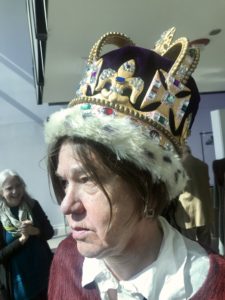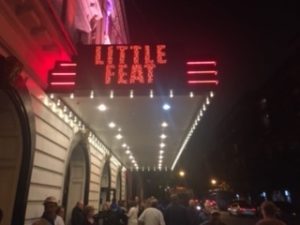Still haven’t seen the movie – or a single episode on television – but after meeting Brendan Coyle, a.k.a. Mr. Bates at Goodman Theater earlier this year, I guess I just can’t get enough of seeing actors from Downton Abbey live on stage! When I signed up for the touch tour of “The King’s Speech” at Chicago Shakespeare Theatre last Sunday, I had no idea that Harry Haddon-Paton, the actor playing the lead, had been in Downton Abbey, too. My friend Laura came along for the touch-tour and the performance, and she generously offered to write this guest post to give you a sighted-eye view.
by Laura Ikens
I’d been intrigued by the touch tours Beth talks about and had maybe not-so-subtly offered to accompany her to one. Finally it was my chance! Even better, it was for The King’s Speech, playing at the Chicago Shakespeare Theater.
Like many of us, I had seen the movie (and thought Colin Firth was pretty dreamy) and was familiar with the story, but with the passing of almost ten years it had faded in my memory. I jumped at Beth’s offer.

Beth was queen for a day…err, minute.
We were greeted at the theater by numerous members of the staff who directed us to our starting point, where they had three of the costumes (the real costumes, the very ones the actors would be wearing on stage!) on dressmaker dummies for us to pore over. Costumers from the show were on hand to give us the back story on each piece. Beth an I were encouraged to touch the fabric, the buttons, the medals — everything.
The first was the suit of the speech therapist, Lionel Logue. Created of warm brown herringbone wool, the suit was impeccably tailored and rumpled on purpose to mimic Lionel’s style.
Next was an outfit for Queen Elizabeth, more popularly known to us as the Queen Mum (she was the Queen before she was the Mum!). With detail almost like dotted swiss but a bit bigger, in a rich pink fabric with silk collar, the dress was so evocative of class and period. And the coat! Gosh, I wanted to put it on and wear it home!
Interesting to note that Beth appreciated having the costumes displayed on dressmaker dummies. That allowed her to feel the fabrics with structure and picture how they might fit.
The piece de resistance was the uniform of the king. The braids, the brocades, the medals! So true to life. The costumers and wigmakers were generous with their time, chatting with us beforehand and explaining why it was so important to keep as true to life as possible. They knew history buffs would call them out on their mistakes. We also learned a lot about how they manage the quick costume changes between scenes (some Velcro and a lot of nimble fingers!).
There was also a table of accessories, including shoes and hats and crowns. Beth asked if she could try some on, and they answered with an easy, “Sure!” I thought Beth made quite the sovereign.
The costumes were just the beginning, though, to get us primed. Next we were treated to a brief lecture by Marilyn Halperin, the Director of Education and Communications. She spoke of the background of the play and the historical context. When she described how the stage and set were designed, we learned the play would be staged in the new theater at Chicago Shakespeare. A proscenium design, the new theatre is able to be converted to various configurations, vs. the thrust design of the legacy theater. Who knew?
Various pieces of the play’s sets were available for the tour attendees to touch and explore. It was interesting to hear that Beth was not as much into the set tour. Her perspective was that having been sighted prior to becoming blind, she could picture a desk or a bookshelf, so had no need to go on stage to touch and understand those objects.
The model airplanes (a hobby of both Logue and the future king), were a different story. They were a key feature of the play, and a staff member brought one over for Beth to touch. So thoughtful.
The crown jewel of the tour was the actor appearances. The six main actors in the play lined up at the front of the stage, and each chatted briefly about their role in the play, their appearance and/or physicality and how they might approach that in their portrayal. Each gave us a few lines from the play, too, and it was astonishing to witness the gentleman playing Winston Churchill transform from a khaki-and-flannel wearing American Joe to the British leader in front of our eyes — and Beth’s ears!
Also amazing was to hear actor Harry Haddon-Paton transform his posh native accent into the stammer that plagued Bertie, the reluctant king. What a treat to be able to hear about their portrayals and how they think of their characters.
The play itself was so enjoyable. If you don’t know the story, Bertie (King George VI) is reluctantly thrust into the kingship after his profligate brother decides on a partner considered unsuitable for a king. Bertie has a stutter that causes those around him from childhood to think him dim and unsuited to the throne. With the help of his unorthodox speech therapist, Bertie conquers his impediment and becomes the resolute ruler Britain needs to lead it through the second Great War.
One may have opinions on the place of the monarchy in modern society, and we’re not here to argue that. But George saw the United Kingdom through a dark time, and this story humanizes his leadership.
If you’re interested, tickets are still available for The King’s Speech at the Chicago Shakespeare Theatre — it runs through October 20, 2019.




